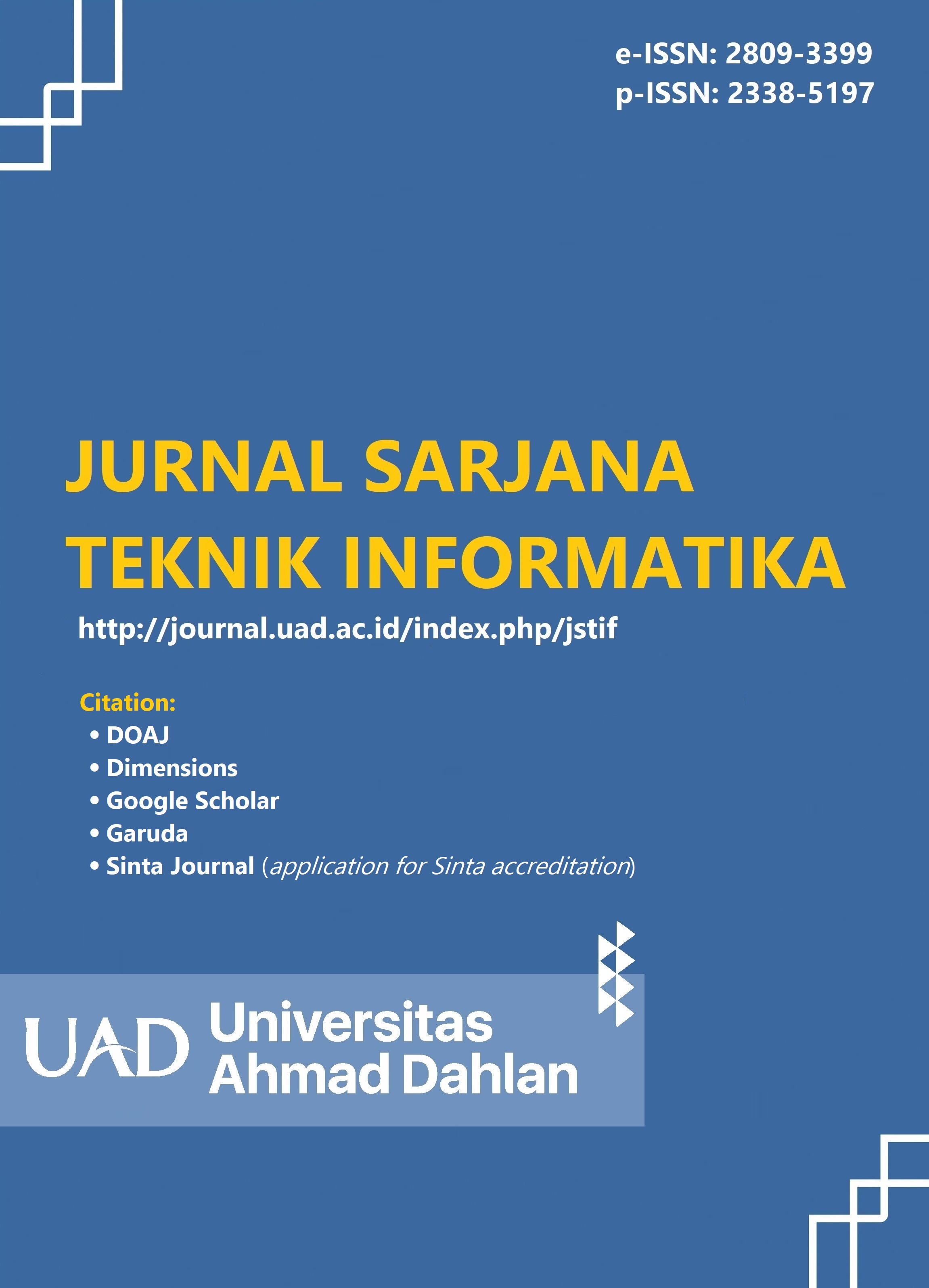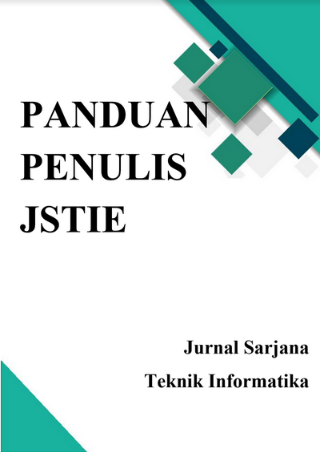Analisis Keamanan Pesan Text Menggunakan Kriptografi Hybrid CBC dan RC 4
DOI:
https://doi.org/10.12928/jstie.v12i2.26334Keywords:
CBC, RC4, Kriptografi Hybrid, Algoritma Kombinasi, KriptografiAbstract
Algoritma CBC banyak digunakan untuk mengamankan pesan berbasis teks, contohnya record database dan enkripsi pesan/file berbasis teks. Algoritma RC4 banyak diimplementaskan untuk protokol SSL, WPA, enkripsi citra digital, enkripsi file/pesan, pengamanan smart card, dan enkripsi database. Algoritma CBC memiliki kekurangan pada kunci yang digunakan untuk enkripsi setiap block sama sehingga memungkinkan terjadinya cipherteks yang berulang dan algoritma RC4 memiliki kekurangan pada array S yang dapat berulang jika kunci yang dimasukan memiliki karakter yang berulang sehingga menghasilkan nilai permutasi yang sama. Penelitian ini bertujuan untuk mengkombinasikan algoritma CBC dan RC4 untuk mengamankan pesan pada file dengan format *.txt. Kombinasi algoritma akan diimplementasikan kedalam aplikasi enkripsi dan dekripsi berbasis web menggunakan bahasa pemrograman PHP. Hasil dari penelitian ini yaitu algoritma kombinasi CBC dan RC4 dapat diimplementasikan dan berjalan dengan baik pada aplikasi berbasis web. Proses enkripsi dan dekripsi dapat dilakukan dengan baik, kecuali terhadap karakter dengan kode extended ASCII antara 128 – 255 tidak dapat dikembalikan seperti semulai ketika didekripsi. Jumlah karakter pada file berpengaruh terhadap running time enkripsi dan dekripsi. Hasil pengujian avalanche effect mendapat nilai antara 45% - 48%. Pesan pada file yang telah terenkripsi tidak dapat terbaca karena sudah teracak dan sangat sulit dimengerti.References
M. Danuri, “Development and transformation of digital technology,” Infokam, vol. XV, no. II, pp. 116–123, 2019.
K. Nassif Jassim et al., “Hybrid cryptography and steganography method to embed encrypted text message within image,” in Journal of Physics: Conference Series, 2019, vol. 1339, no. 1, doi: 10.1088/1742-6596/1339/1/012061.
D. D. A. Yani, H. S. Pratiwi, and H. Muhardi, “Implementasi Web Scraping untuk Pengambilan Data pada Situs Marketplace,” J. Sist. dan Teknol. Inf., vol. 7, no. 4, p. 257, 2019, doi: 10.26418/justin.v7i4.30930.
F. Cochoy, C. Licoppe, M. P. McIntyre, and N. Sörum, “Digitalizing consumer society: equipment and devices of digital consumption,” J. Cult. Econ., vol. 13, no. 1, pp. 1–11, 2020, doi: 10.1080/17530350.2019.1702576.
J. Rengamani, F. A. James, R. Srinivasan, S. Poongavanam, and R. Vettriselvan, “Impact on the usage of electronic data interchange (EDI) on the international shipping business in Chennai,” Int. J. Eng. Adv. Technol., vol. 8, no. 2, pp. 418–422, 2019.
K. Thakur, T. Hayajneh, and J. Tseng, “Cyber Security in Social Media: Challenges and the Way Forward,” IT Prof., vol. 21, no. 2, pp. 41–49, 2019, doi: 10.1109/MITP.2018.2881373.
O. K. Sulaiman, K. Nasution, and S. Y. Prayogi, “Enkripsi Surat Elektronik Menggunakan Metode XXTEA,” Comput. Eng. Sci. Syst. J., vol. 4, no. 1, p. 99, 2019, doi: 10.24114/cess.v4i1.12354.
F. A, F. Yanto, I. Iskandar, and Pizaini, “Jurnal Computer Science and Information Technology ( CoSciTech ) Kombinasi algoritma kriptografi vigenere cipher dengan metode zig-zag dalam pengamanan pesan teks,” vol. 4, no. 1, pp. 182–192, 2023, doi: https://doi.org/10.37859/coscitech.v4i1.4787.
S. N. Siregar, “Pengamanan Pesan Teks Menggunakan Algoritma FEAL dan RSA Pada Aplikasi Android,” J. Comput. Syst. Informatics …, vol. 1, no. 4, pp. 328–336, 2020, [Online]. Available: https://ejurnal.seminar-id.com/index.php/josyc/article/view/351.
F. Nova Hulu, M. Putri, and K. Kunci, “Metode Analitis Enkripsi Dan Dekripsi Dengan Penerapan Algoritma Kriptografi Klasik Ke Dalam Cipher,” J. Elektro dan Telkomunikasi, pp. 26–34, 2022.
E. Sutanty, M. B. Siregar, and E. Setiyaningsih, “Implementasi Feistel Block Cipher Dalam Enkripsi File Berbentuk Teks,” J. Ilm. Inform. Komput., vol. 26, no. 2, pp. 136–148, 2021, doi: 10.35760/ik.2021.v26i2.4238.
R. Munir, “IF4020 Kriptografi - Semester I Tahun 2021/2022,” https://informatika.stei.itb.ac.id/~rinaldi.munir/Kriptografi/2021-2022/kripto21-22.htm, 2021. https://informatika.stei.itb.ac.id/~rinaldi.munir/Kriptografi/2021-2022/kripto21-22.htm (accessed Oct. 21, 2022).
N. R. D. P. Astuti, I. Arfiani, and E. Aribowo, “Analysis of the security level of modified CBC algorithm cryptography using avalanche effect,” IOP Conf. Ser. Mater. Sci. Eng., vol. 674, no. 1, 2019, doi: 10.1088/1757-899X/674/1/012056.
A. F. Doni, O. A. H. Maria, and S. Hanif, “Implementation of RC4 Cryptography Algorithm for Data File Security,” J. Phys. Conf. Ser., vol. 1569, no. 2, pp. 2–8, 2020, doi: 10.1088/1742-6596/1569/2/022080.
R. Mohammed and L. M. Jawad, "Secure Image Encryption Scheme Using Chaotic Maps and RC4 Algorithm," Solid State Technology, vol. 63, no. 3, pp. 3450-3465, Nov. 2020
K. N. Suryani, “Algoritma Rc4 Sebagai Metode Enkripsi,” Enkripsi, vol. 4, p. 5, 2009.
S. Purba, “Kriptanalisis Kunci Publik Algoritma Rabin Menggunakan Metode Kraitchik,” Jurnal Sains dan teknologi, vol. 11, no. 2. pp. 205–213, 2019, [Online]. Available: https://ejurnal.istp.ac.id/index.php/jsti/article/view/25.
M. Karuppiah, S. Ramanujam, and A. Professor, “Designing an algorithm with high Avalanche Effect,” IJCSNS Int. J. Comput. Sci. Netw. Secur., vol. 11, no. 1, p. 106, 2011, [Online]. Available: https://www.researchgate.net/publication/266468045.
S. Suhandinata, R. A. Rizal, D. O. Wijaya, P. Warren, and S. Srinjiwi, “ANALISIS PERFORMA KRIPTOGRAFI HYBRID ALGORITMA BLOWFISH DAN ALGORITMA RSA,” JURTEKSI (Jurnal Teknol. dan Sist. Informasi), vol. 6, no. 1, pp. 1–10, 2019, doi: 10.33330/jurteksi.v6i1.395.
J. Jamaludin and R. Romindo, “Rancang Bangun Pengamanan Teks Menggunakan Kombinasi Vigenere Cipher dan RSA dalam Hybrid Cryptosystem,” Pros. Semin. Nas. Ris. …, vol. 2, pp. 105–116, 2020, [Online]. Available: http://tunasbangsa.ac.id/seminar/index.php/senaris/article/view/150/0.
K. Mohamed, “Analyse On Avalanche Effect In Cryptography Algorithm,” in Proceedings of the International Conference on Sustainable Practices, Development and Urbanisation (IConsPADU 2021), 16 November 2021, Universiti Selangor (UNISEL), Malaysia, Oct. 2022, vol. 3, pp. 610–618, doi: 10.15405/epms.2022.10.57.
Downloads
Published
Issue
Section
License
License and Copyright Agreement
In submitting the manuscript to the journal, the authors certify that:
- They are authorized by their co-authors to enter into these arrangements.
- The work described has not been formally published before, except in the form of an abstract or as part of a published lecture, review, thesis, or overlay journal. Please also carefully read Journal Posting Your Article Policy.
- The work is not under consideration for publication elsewhere.
- The work has been approved by all the author(s) and by the responsible authorities – tacitly or explicitly – of the institutes where the work has been carried out.
- They secure the right to reproduce any material that has already been published or copyrighted elsewhere.
- They agree to the following license and copyright agreement.
Copyright
Authors who publish with Jurnal Sarjana Teknik Informatika agree to the following terms:
- Authors retain copyright and grant the journal right of first publication with the work simultaneously licensed under a Creative Commons Attribution License (CC BY-SA 4.0) that allows others to share the work with an acknowledgement of the work's authorship and initial publication in this journal.
- Authors are able to enter into separate, additional contractual arrangements for the non-exclusive distribution of the journal's published version of the work (e.g., post it to an institutional repository or publish it in a book), with an acknowledgement of its initial publication in this journal.
- Authors are permitted and encouraged to post their work online (e.g., in institutional repositories or on their website) prior to and during the submission process, as it can lead to productive exchanges, as well as earlier and greater citation of published work.








